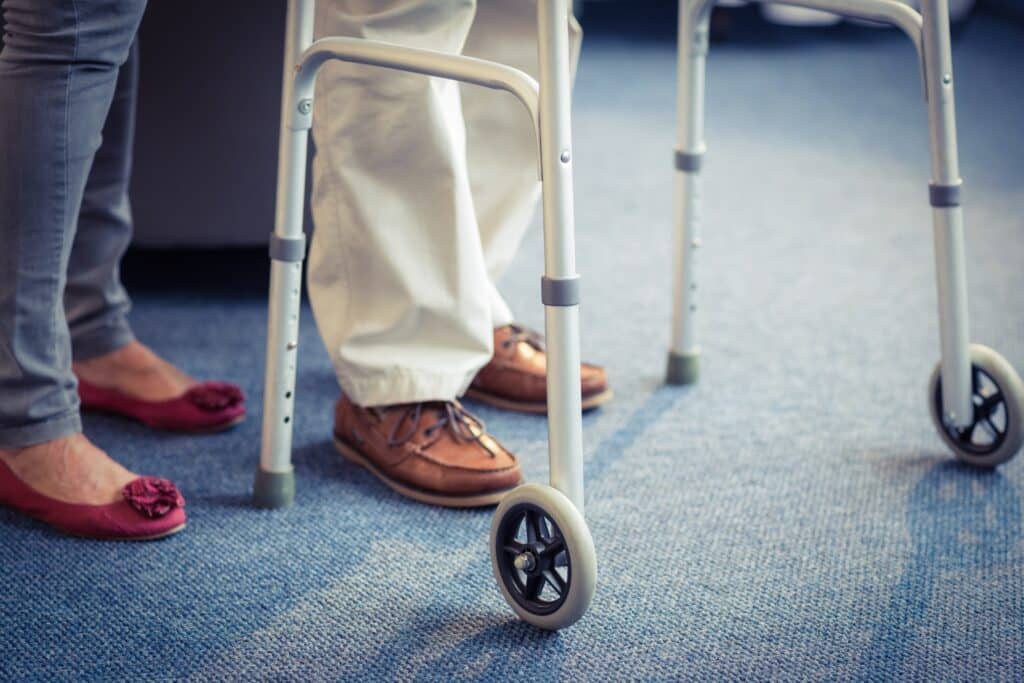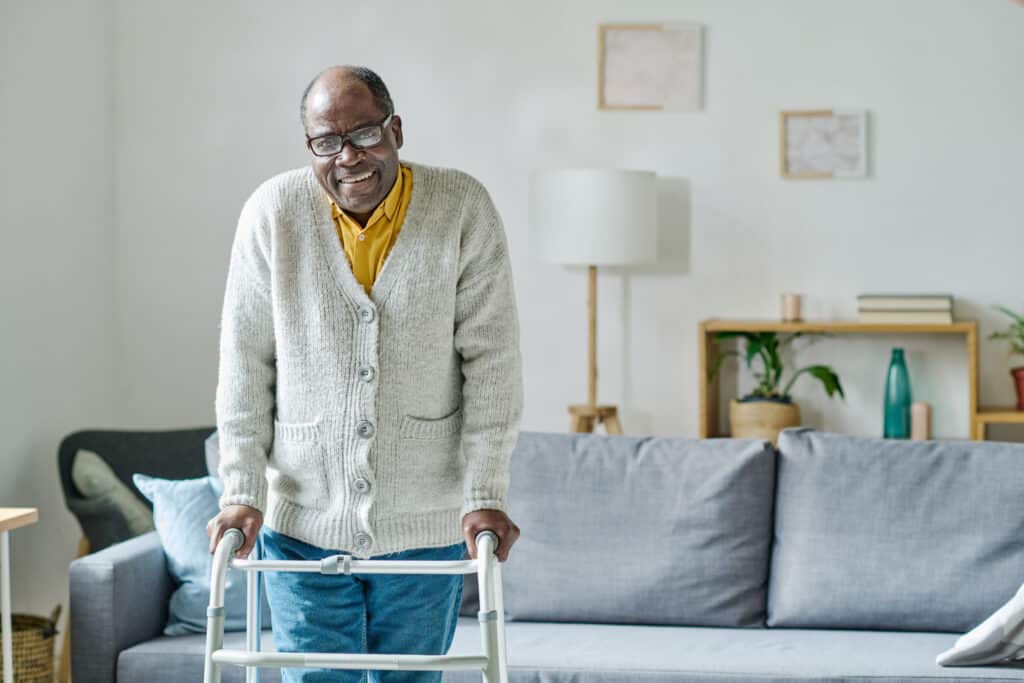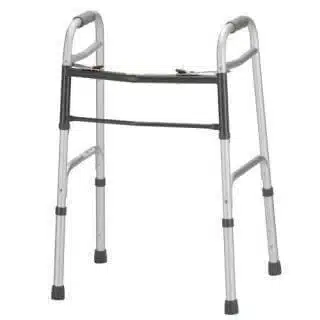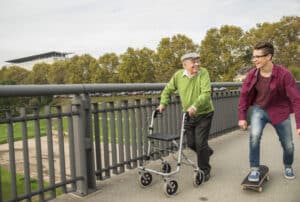If your doctor has encouraged you to do so, choosing the best walker for you may seem intimidating. However, mastering the nuances of your walker will not only ensure safety and efficiency but significantly enhance your mobility and independence.
Although any walker for seniors is designed to encourage safe movement, it’s crucial to recognize that getting used to using one requires a blend of time, patience, and practice. Choosing the best walker may take time, but being safer, more confident, and mobile will be worth the effort.
This article will guide you through understanding different types of walkers, offering fitting tips, outlining movement techniques, and suggesting beneficial exercises to perform with your walker once you feel comfortable maneuvering with it.
Types of Walkers

There are many walkers for seniors on the market, each designed to meet diverse needs. It can be easy to get overwhelmed, but don’t worry because you’re not alone! Your healthcare provider or physical therapist will gladly guide you when choosing the best walker.
Here is a brief rundown of the most commonly available walkers available today.
Standard Walkers vs. Wheeled Walkers
Standard walkers offer the most stability with their four non-skid legs, but they require a bit of lifting to move around. However, some users prefer having walker slides attached to the legs of these walkers to facilitate a more effortless sliding motion, requiring less lifting.
Make a Solid Choice in a Standard Walker
The
Our recommendations are the same items we trust and prescribe to patients. When you buy through links like this on our site, we may earn an affiliate commission to support new content.
In contrast, a rolling walker can provide several options that offer different levels of mobility for various reasons.
A two-wheeled walker with wheels on the front two legs can be an excellent choice for those needing weight-bearing assistance while remaining mobile.
Three-wheeled walkers stand out due to their lightweight design and maneuverability. Still, they tend to be less stable and supportive for balance-challenged people.
If you don’t require leaning on your walker for support, a four-wheeled walker with wheels on all legs may be a viable option. Options like a rollator walker provide a greater range of mobility options. But they are less reliable for stability and support.
What’s the Best Walker for Getting Stuff Done?
If you are someone who can use a little help with mobility, balance, or endurance, but who does not need to fully off-load a lower limb, you are a good candidate for a rollator like this one from Drive Medical. The Drive Medical Folding Aluminum Rollator makes a great rollator for getting you around the house, the park, or around town. This rollator is stable but built for moving. The big 6″ wheels make it able to roll over most terrain without lifting the walker. And there’s storage for shopping, with back support & a padded seat for when you need to rest.
Our recommendations are the same items we trust and prescribe to patients. When you buy through links like this on our site, we may earn an affiliate commission to support new content.
Other Specialized Walkers for Seniors
Knee walkers, conversely, are reminiscent of kick scooters and feature a rest area for your knee and small handlebars for steering. These are most commonly recommended as an alternative to crutches for those recovering from knee or ankle surgery and who have one fully functional leg and good balance.
Bariatric walkers are specialized for those who are obese and are often recommended for patients who require a greater width and weight capacity to suit their needs. A bariatric walker is often recommended for people preparing for or having had a bariatric surgery procedure.
Furthermore, some walkers come loaded with features, including brakes, a padded seat, and baskets catering to a range of needs and preferences.
Whatever your choice, ensuring your walker is easy to fold for effortless transport is vital. Many of the simpler models are lightweight and foldable. This is known as a button folding walker., a popular model being the Life Space Saver Walker.
General Safety Tips for Choosing & Using Your Walker

Household objects like dog toys, extension cords, and bunched rugs can cause unexpected hazards for seniors, either with or without a walker.
While using your new walker, prioritizing safety is your primary goal. Here are some essential tips for safely using your walker.
Tips for Moving Safely with Your Walker
While a standard walker requires a lift-and-place motion, a walker with wheels can be pushed forward without lifting and can sometimes get away if you’re unprepared.
If you have been fitted for a walker without wheels, make sure you feel comfortable repeatedly lifting your walker, and if you have a wheeled walker, ensure that you feel comfortable with its more mobile design.
It’s best always to keep an eye on your posture, refraining from hunching over your walker, as many walker users may become overly reliant on them. If you find yourself leaning or hunching forward more often than usual, consult your doctor to explore methods to become less reliant on your new walker.
Ensure you maintain a safe distance from your walker to prevent imbalances. Always ensure your walker’s four legs or wheels touch the ground before you bear any weight on it. While walkers are designed for safety, it is also possible to trip or lose your balance.
Remember to look forward, not down at your feet, when using your walker. Even with the support of your walker, it is essential to maintain posture and be aware of your surroundings.
Safety Considerations for Your Home and Walker Maintenence Tips
Keeping your house free of tripping hazards like cords and loose carpets and maintaining clean and dry floors is vital. While your walker will be helpful, taking proactive measures to keep your home safe from hazards is also essential. If you don’t feel like you can do this, talk to your children, grandchildren, or your doctor to get some assistance.
Regularly inspect your walker and replace worn-out leg tips or wheels as necessary. Walkers are built to the standard of other durable medical equipment but wear out over time. Purchase replacement parts as needed, and always talk to your doctor if you feel unsafe using your walker.
A small basket or bag attached to your walker can come in handy for carrying small items, freeing both hands to grip the walker.
Use chairs with armrests to facilitate the transition between sitting and standing. This can make tricky transitions from seated to standing easier, but ensure your walker is secure once you have your footing.
If you’re struggling to use your walker, don’t hesitate to seek help from your doctor or physical therapist.
Finally, one of the most important actions we can recommend is to confirm that your walker is correctly fitted to your body.
Choosing the Best Walker For Your Body

A correctly fitted walker is crucial for its practical use. It ensures that your arms rest comfortably, thereby minimizing stress on your shoulders and back.
If your walker is too low, it may encourage slouching and become a tripping hazard. If your walker is too high, you may have difficulty moving it. You may also encounter neck and shoulder pain from the awkward position.
Step inside your walker’s fitting and check the following two qualities to make sure your walker is appropriately sized.
- First, with your shoulders relaxed, place your hands on the walker’s grips. Your elbows should be angled at approximately 15 degrees.
- Then, while standing inside the walker, without holding onto the grips, the top grip should align with your hip level.
Consult your physical therapist to help you adjust your walker as needed.
Key Takeaways
- Choosing the best walker for your needs depends on your health conditions, balance and what makes you feel safe and comfortable.
- Walkers for seniors come in various types, including standard walkers, wheeled walkers, knee walkers, and bariatric walkers. Each variety is designed to meet different mobility needs and preferences.
- Standard walkers offer the most stability, while wheeled walkers provide more mobility. Knee walkers are suitable for those recovering from lower limb surgeries, and bariatric walkers are designed for obese individuals.
- Safety is paramount when using a walker. Always ensure the walker’s four legs or wheels touch the ground before bearing any weight, maintain a safe distance from the walker, and keep an eye on your posture.
- Regularly inspect your walker for wear and tear and replace worn-out parts. A small basket or bag attached to your walker can be helpful for carrying small items.
- A correctly fitted walker is crucial for comfort and efficiency. Your walker should be at hip level, and your elbows should be angled at approximately 15 degrees when your hands are on the grips.
- Always consult your healthcare provider or physical therapist when choosing a walker and for help fitting and using it safely.
FAQs
How do I choose the best walker for my needs?
Choosing the best walker depends on your health condition, balance, and mobility needs. Standard walkers offer stability, while wheeled walkers provide more mobility. Your healthcare provider or physical therapist can guide you in selecting the most suitable walker based on your specific requirements.
What are the differences between a standard walker and a wheeled walker?
A standard walker has four non-skid legs that provide maximum stability but require lifting to move. A wheeled walker has wheels on some or all legs, making it easier to move without lifting, but it may offer less stability. Your choice depends on your balance, strength, and mobility needs.
How do I ensure my walker is fitted correctly?
To ensure your walker is properly fitted, your elbows should be angled at around 15 degrees when holding the grips, and the top grip should align with your hip level. A correctly fitted walker minimizes stress on your shoulders and back, making movement easier and safer.
What safety tips should I follow when using a walker?
Always ensure that all four legs or wheels of your walker are on the ground before bearing weight on it. Keep your posture upright, avoid leaning too far forward, and maintain a safe distance from your walker to prevent falls. Regularly inspect your walker for wear and replace parts as needed.
Are there specialized walkers for specific needs?
Yes, there are specialized walkers for different needs. Knee walkers are great for those recovering from lower limb surgeries, while bariatric walkers are designed for individuals requiring a higher weight capacity. Your healthcare provider can recommend the best option based on your unique situation.
References
- Bateni, H., Maki, B. E. (2005). Assistive devices for balance and mobility: benefits, demands, and adverse consequences. Archives of Physical Medicine and Rehabilitation, 86(1), 134-145. https://www.archives-pmr.org/article/S0003-9993(04)01252-7/fulltext
- Bateni, H., Heung, E., Zettel, J., McLlroy, W. E., & Maki, B. E. (2004). Can use of walkers or canes impede lateral compensatory stepping movements?. Gerontology, 50(5), 337-342. https://www.karger.com/Article/Abstract/78963
- Brouwer, B., Musselman, K., & Culham, E. (2004). Physical function and health status among seniors with and without a fear of falling. Gerontology, 50(3), 135-141. https://www.karger.com/Article/Abstract/76920
- Villareal, D. T., Apovian, C. M., Kushner, R. F., & Klein, S. (2005). Obesity in older adults: technical review and position statement of the American Society for Nutrition and NAASO, The Obesity Society. The American journal of clinical nutrition, 82(5), 923-934. https://academic.oup.com/ajcn/article/82/5/923/4607499
- Shumway-Cook, A., Ciol, M. A., Yorkston, K. M., Hoffman, J. M., & Chan, L. (2005). Mobility limitations in the Medicare population: prevalence and sociodemographic and clinical correlates. Journal of the American Geriatrics Society, 53(7), 1217-1221. https://agsjournals.onlinelibrary.wiley.com/doi/full/10.1111/j.1532-5415.2005.53372.x







